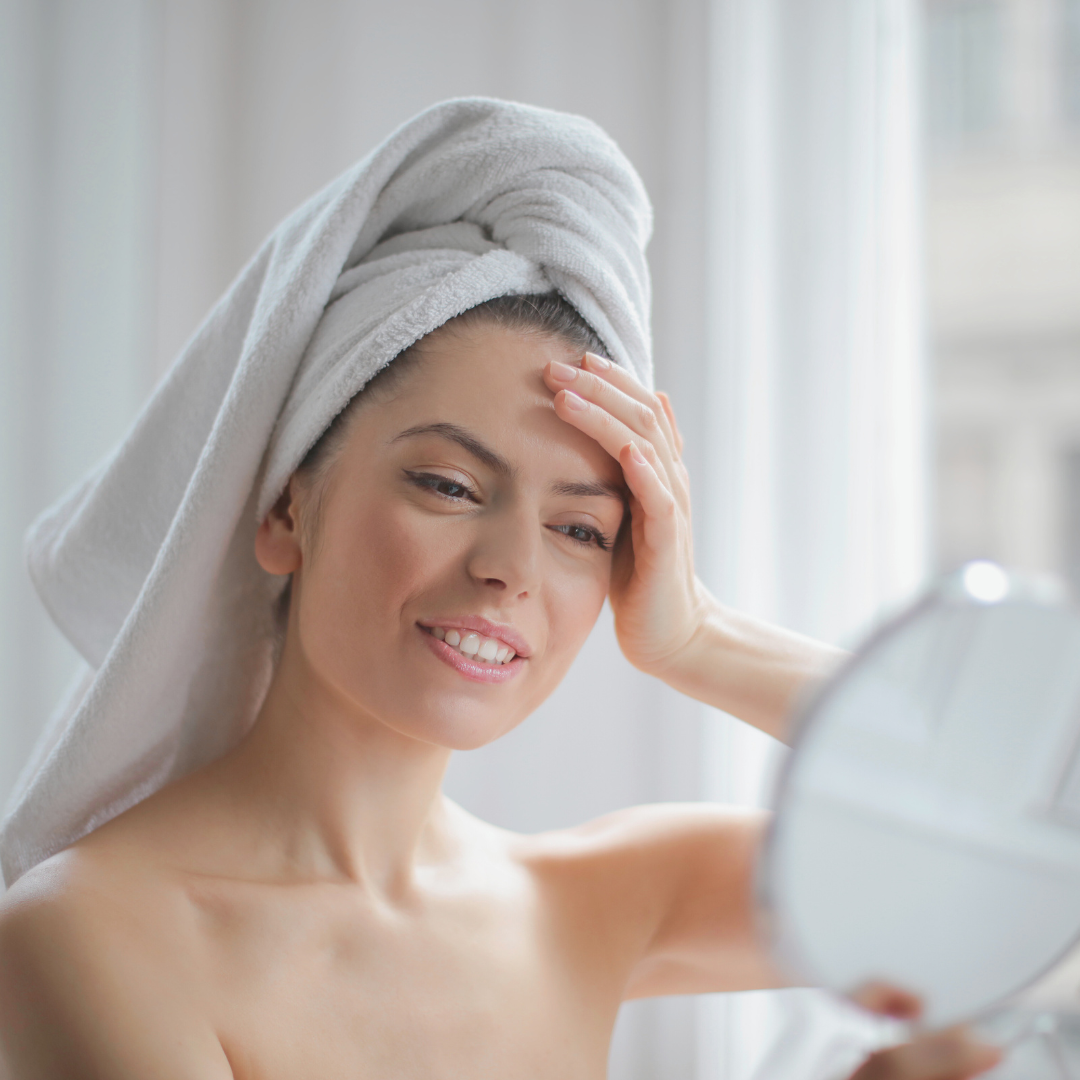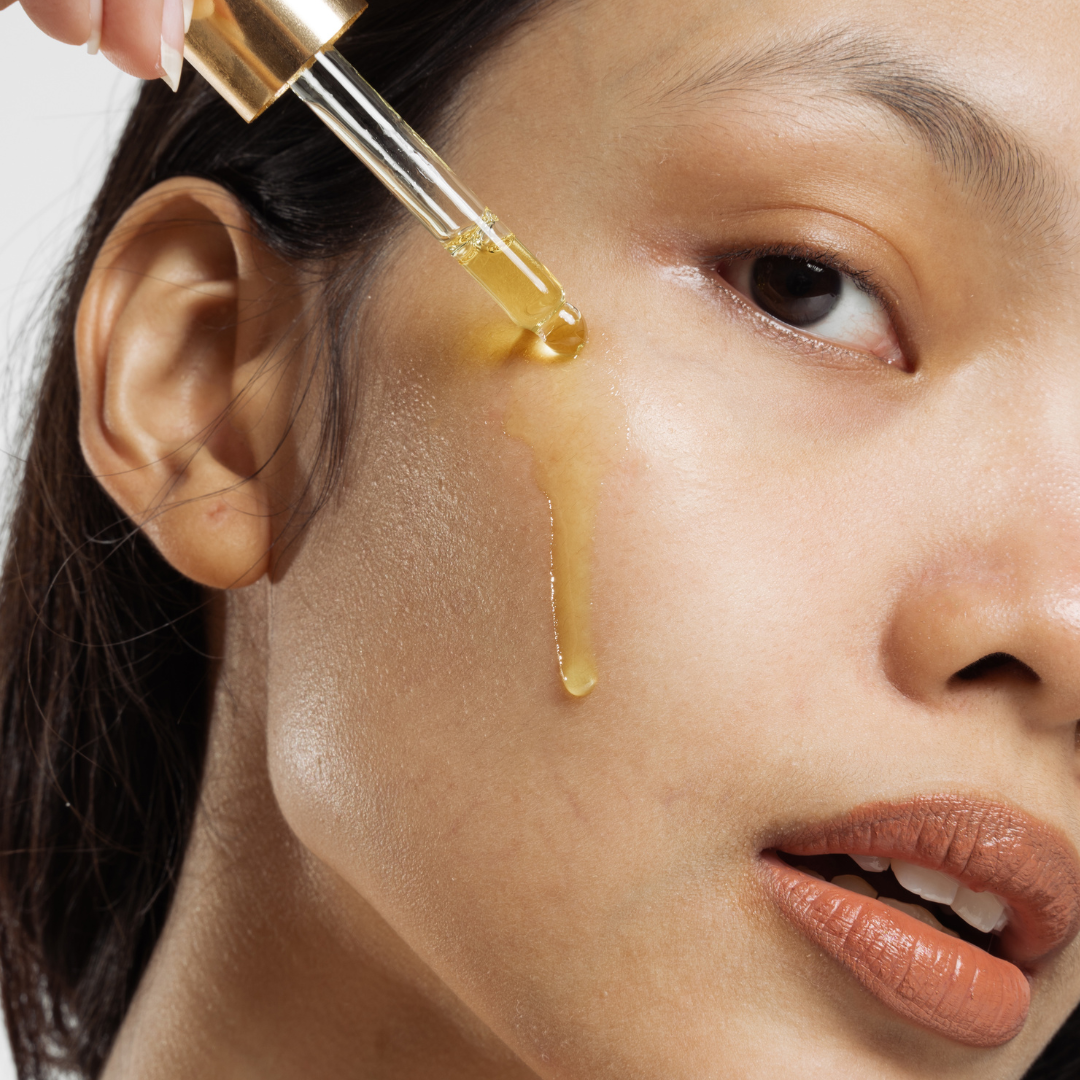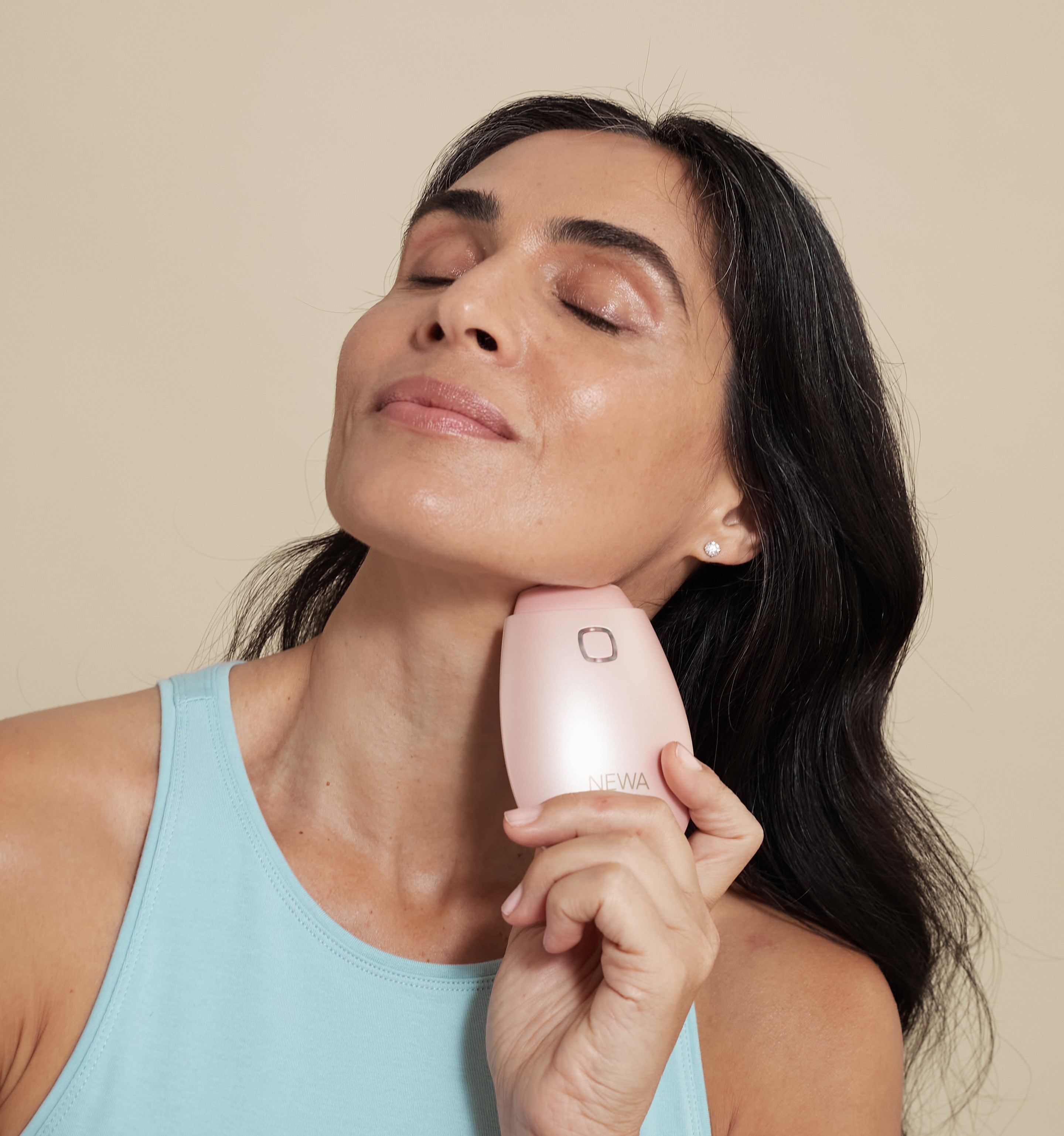Perhaps one of the facial areas most prone to wrinkles as we age is our forehead. They include horizontal lines as well as the infamous 11 lines: two vertical wrinkles that appear between the eyebrows. So what causes forehead wrinkles? What is the best product for forehead wrinkles? And what are some forehead wrinkles treatments for these lines and for preventing them? We’re answering your questions.
What causes forehead wrinkles?
There are different reasons why wrinkles on the forehead can appear as we age.
Collagen loss
The main cause of deep forehead wrinkles is the same as for all wrinkles: natural loss and declining production of Collagen and Elastin in our skin. Collagen, as well as Elastin are two proteins responsible for skin firmness, tightness and elasticity. They are stored in the our skin’s middle layer, called the Dermis, accounting for about 90% of your skin’s thickness[1]. Collagen provides rigidity and strength to the skin while elastin allows the skin to be flexible and bounce back to its original shape. In other words, the combination of the two is what keeps our skin from sagging and wrinkles from forming, including on the forehead. Between the ages of 20 and 30, however, our natural production of these essential proteins starts declining fast: we lose about 1% of collagen every year.
Muscle movements
Repeated muscle movements like raising your eyebrows can also emphasize forehead wrinkles. The raising of the frontalis muscle, located in our forehead, pulls the skin of the forehead upwards. That is why horizontal wrinkles can appear. This is a natural phenomenon as we express ourselves with our face every day.[2]
Sun exposure
Once again, the sun is a major culprit when it comes to forehead wrinkles sun exposure. Damage to skin caused by sun exposure happens when ultraviolet (UV) light emitted by the sun hits our skin and changes cellular DNA. This occurs in the deeper layer of the skin known as the Dermis. It can take years before the damage reaches the epidermis (the surface of our skin). This means that wrinkles on the forehead may be caused by exposure to the sun from years before.[3]
Genetics
As for every type of wrinkle or skin condition, genetics may also be a cause for premature signs of aging. Although there is not much that can be done about this, It’s important to be aware of the fact that some of the reasons we experience fine lines and wrinkles on our face are completely outside of our control.
How to reduce forehead wrinkles with these top treatments.
Creams and Patches
If you tend to opt for a topical solution, you may be looking for the best cream for forehead wrinkles. Dermatologists usually recommend creams formulated ingredients such as peptides, hyaluronic acid, retinol[4] or ceramides. These are all ingredients known for their wrinkle-reducing properties. As another topical option, some skincare brands produce patches (similar to sheet masks or eye patches) to use on the forehead. They act as a form of cast for our frontalis muscle to restrict expressions that can emphasize and cause wrinkles on the forehead. They usually require a minimum of 3 hour wear. These topical solutions are easy to use but you should take into consideration that results don’t appear overnight and you have to be very consistent about applying them to experience any change. The earlier and more consistently you start using these, the better.
Tretinoin for forehead wrinkles
Among anti-aging creams for the forehead, there is also much talk about the efficiency of an ingredient called Tretinoin. Tretinoin is a synthetic form of vitamin A that requires a prescription and is significantly stronger than retinol. It is probably the best forehead wrinkle topical product and can help prevent the breakdown of collagen and thus help slow down the formation of new wrinkles. It is is considered the benchmark prescription topical therapy for improving fine facial wrinkles[5]. Creams with Tretinoin are set apart from other creams on the market because while the other non-prescription products are known to be well tolerated and cause little side effects, Tretinoin isn’t always well received by everybody’s skin, but it is definitely more effective[6]. Looking at tretinoin for forehead wrinkles before and after comparisons, there is no doubt it works better and faster than other creams.
Botox for forehead wrinkles
Botox is one of the most effective and common ways to remove forehead wrinkles. As you may already know, it consists of an injection to the site of the wrinkles which relaxes the muscles in the forehead, therefore reducing the creases, even when you make facial movements. This is probably the fastest way to get rid of forehead wrinkles. However, some points are important to remember. First, the effects of a botox injection are only temporary and the procedure should be done every 3 to 4 months to continue seeing results. Because it basically freezes the facial muscles to keep you from contracting them in a way that deepens wrinkles, it’s much more of a preventative treatment than a real solution against the wrinkles[7]. In addition, it does require some down time after the injection and if you’re sensitive to needles, this might not be for you.
Radio Frequency Therapy
If you’re not into needles and you are looking to get rid of forehead wrinkles more naturally, radio frequency (RF) therapy is a great forehead wrinkles treatment. If you’ve never heard of it, Radio frequency therapy works by using energy waves – known as radio waves– to help boost the skin’s natural production of collagen and elastin, two proteins responsible for firming and tightening the skin, and which we lose as we age. When it comes to forehead wrinkles, RF therapy can be performed in clinic by a professional
If you’re interested in trying Radio frequency therapy at home, the technology is also available in a compact device such as the NEWA RF wrinkle reduction device. While it isn’t for the forehead area, NEWA has been clinically proven to reduce signs of aging on the cheeks and jawline.
Tips to Prevent Forehead Wrinkles
Sun exposure
The sun is the skin’s biggest enemy. As such, protecting our skin from its UVA/B rays is essential to prevent premature signs of aging on our skin. Sunscreen with a high SPF should already be a part of your skincare routine, but if you haven’t made it a habit, it’s never too late to start. Remember: there is sunshine outside even on rainy winter days! Protecting your skin is essential. There are many different types of SPF formulas out there, so finding the right product for your skin type and lifestyle should be easy as well.
Expression / botox
As explained earlier, much of the forehead wrinkles we experience are also due to muscle movements in our face. Being mindful of how you move your face and how often you raise your eyebrows could help limit the deepening and visibility of forehead wrinkles. These movements, however, are natural and not easy to control. Considering getting Botox injections to freeze the frontalis muscle in our forehead is a good way to prevent such movements as well.
Get RF treatments
As mentioned above, radiofrequency therapy, which uses energy waves to stimulate collagen production in the skin, is a great treatment for forehead wrinkles. These are performed in clinic by a professional with a forehead-adapted attachment. New collagen formation starts 4 to 6 weeks after each treatment. This means that after a month, you’re going to just start seeing the effects of the very first cycle you did. That’s why RF treatments for the forehead can be a great prevention tool for fine lines and wrinkles.
FAQs
Why is my forehead aging so fast?
Forehead wrinkles can appear at an early age. If that is your case you may be wondering if it is normal to have forehead wrinkles at 18 or around that age. The answer is yes, it could be. Factors such as sun exposure without protection in your childhood or genes may be the reasons you experience forehead wrinkles young. This is outside of your control, but following some of the steps in this article, you will be able to visibly reduce them and prevent new ones from forming or the present ones from deepening.
Does face yoga work for forehead wrinkles?
There are tips and tricks you can find online about how to use massages and face yoga exercises to reduce forehead wrinkles at home. However, the results are minimal and it would take a lot of repetitions on a daily basis to achieve any apparent change.
Conclusion
In conclusion, addressing forehead wrinkles involves understanding their various causes, such as collagen loss, muscle movements, sun exposure, and genetic factors. Collagen and elastin depletion, occurring naturally with age, contribute significantly to the formation of wrinkles. Muscle movements, especially repetitive ones like raising eyebrows, can accentuate these lines. Sun exposure and genetics also play roles in premature aging. To tackle forehead wrinkles, various treatments are available. Topical solutions like creams and patches containing peptides, hyaluronic acid, retinol, or ceramides can be applied consistently for potential improvement. Tretinoin, a prescription-strength form of vitamin A, is recognized for its efficacy in preventing collagen breakdown. Botox injections offer a quick and effective solution by relaxing forehead muscles, but they require periodic maintenance. Preventative measures include sun protection with high SPF, mindful facial expressions, and, if necessary, considering Botox to limit muscle movements. While face yoga and massages are mentioned as potential strategies, their efficacy is limited, requiring consistent and frequent practice. Understanding and addressing the factors contributing to forehead wrinkles can aid in reducing their appearance and preventing further development.
Sources used in the article:




